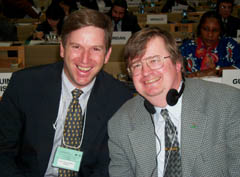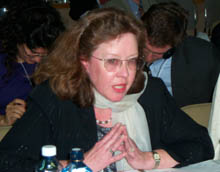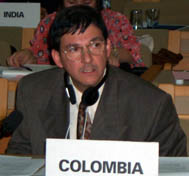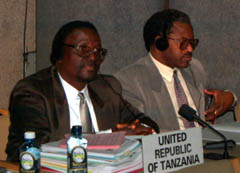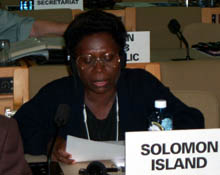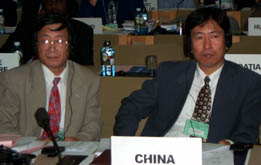 |
| |
 ARGENTINA expressed concern over the work plan, emphasizing
that Article 18 (Handling, Transport, Packaging and Identification)
should be addressed at the ICCP's second meeting. She stated that
ICCP-1 should limit its work to capacity-building, information sharing
and the CHM.
ARGENTINA expressed concern over the work plan, emphasizing
that Article 18 (Handling, Transport, Packaging and Identification)
should be addressed at the ICCP's second meeting. She stated that
ICCP-1 should limit its work to capacity-building, information sharing
and the CHM. |
 |
|
|
 Emphasizing that the ICCP's mandate is confined to preparatory work,
MEXICO
supported adoption of the work plan.
Emphasizing that the ICCP's mandate is confined to preparatory work,
MEXICO
supported adoption of the work plan. |
 Ethiopia said there was no need to bring in the "ghosts
of Cartagena and Montreal" into the ICCP Work Programme
Ethiopia said there was no need to bring in the "ghosts
of Cartagena and Montreal" into the ICCP Work Programme |

|
|
|
 The US stated that pharmaceuticals should remain outside the work
plan as they are beyond the Protocol's scope, and requested clarification
on selection of the biosafety CHM Technical Experts' Group
The US stated that pharmaceuticals should remain outside the work
plan as they are beyond the Protocol's scope, and requested clarification
on selection of the biosafety CHM Technical Experts' Group |
| Plenary:
INTERNATIONAL ORGANIZATIONS STATEMENTS |
 Mohammed El Ashry,
CEO of the Global Environmental Facility (GEF) highlighted its biodiversity
projects and new programmes on ecosystem management and agrobiodiversity,
and offered GEF's assistance in mobilizing additional financial
resources. He noted a recently approved capacity development initiative
in cooperation with UNDP in areas of biodiversity, climate change
and land degradation.
Mohammed El Ashry,
CEO of the Global Environmental Facility (GEF) highlighted its biodiversity
projects and new programmes on ecosystem management and agrobiodiversity,
and offered GEF's assistance in mobilizing additional financial
resources. He noted a recently approved capacity development initiative
in cooperation with UNDP in areas of biodiversity, climate change
and land degradation. |
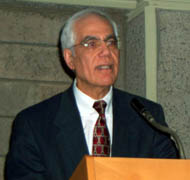 |
|
|
 Jorge Illueca,
UNEP, speaking on behalf of the CITES SECRETARIAT, underscored the
importance of enhancing cooperation between CITES, the CBD and other
biodiversity-related conventions. He reported that at the recent CITES
COP-11, delegates endorsed proposals for synergy on, inter alia,
scientific and technical cooperation, enforcement, capacity-building
and fund-raising.
Jorge Illueca,
UNEP, speaking on behalf of the CITES SECRETARIAT, underscored the
importance of enhancing cooperation between CITES, the CBD and other
biodiversity-related conventions. He reported that at the recent CITES
COP-11, delegates endorsed proposals for synergy on, inter alia,
scientific and technical cooperation, enforcement, capacity-building
and fund-raising. |
 Roberto Lenton, Director Sustainable Energy and Environment
Division (SEED) on behalf of UNDP, noted its continuous commitment
to CBD implementation, highlighting activities in areas such as
biosafety, forests and indigenous peoples. He also highlighted GEF
projects intended to help countries implement the CBD: the Biodiversity
Planning Support Programme; the country dialogue workshop programme
on access to funding; and the Small Grants Programme.
Roberto Lenton, Director Sustainable Energy and Environment
Division (SEED) on behalf of UNDP, noted its continuous commitment
to CBD implementation, highlighting activities in areas such as
biosafety, forests and indigenous peoples. He also highlighted GEF
projects intended to help countries implement the CBD: the Biodiversity
Planning Support Programme; the country dialogue workshop programme
on access to funding; and the Small Grants Programme.
|
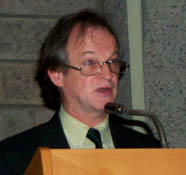 |
Working
Group Two: ALIEN SPECIES |
|
|
COLOMBIA
and BRAZIL introduced a draft decision for an initiative on plant
conservation, for development and consideration at COP-6.
|
|
NIGERIA
speaking for the G-77/CHINA, supported COLOMBIA and BRAZIL's draft
decision and highlighted the importance of medicinal plants.
|
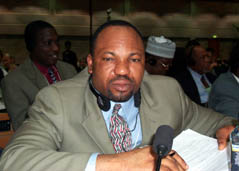 |
|
|
 TANZANIA
supported adopting the interim guidelines on invasive species and
applying the precautionary principle in tandem with local communities
to tackle the problem of transboundary invasion of alien species,
a leading cause of biodiversity loss between regions.
TANZANIA
supported adopting the interim guidelines on invasive species and
applying the precautionary principle in tandem with local communities
to tackle the problem of transboundary invasion of alien species,
a leading cause of biodiversity loss between regions. |
|
|
 KENYA said COP-5 should take a stand against biological agents
aimed at destroying crops and called for GEF support for invasive
species programmes.
KENYA said COP-5 should take a stand against biological agents
aimed at destroying crops and called for GEF support for invasive
species programmes. |
|
|
|
 SOLOMON ISLANDS also called for COP-5 condemnation of all attempts
to eradicate cultivated species with biological pathogens and agents
which can act as invasive species. She also said local awareness
building on such agents and invasives species should be a priority.
SOLOMON ISLANDS also called for COP-5 condemnation of all attempts
to eradicate cultivated species with biological pathogens and agents
which can act as invasive species. She also said local awareness
building on such agents and invasives species should be a priority. |
|
CHINA
proposed addressing GMOs and genotypes as potentially invasive species
|
|
|
|
Side event: CBD Birthday
Cake and Campeau Eulogy
|
|
 Today
was the 8th anniversary of the adoption of the text of the Convention
on Biological Diversity. Hamdallah Zedan, Executive Secretary of
the CBD [top photo, right], convened participants for this
special occasion to share a birthday cake. Today
was the 8th anniversary of the adoption of the text of the Convention
on Biological Diversity. Hamdallah Zedan, Executive Secretary of
the CBD [top photo, right], convened participants for this
special occasion to share a birthday cake.
Veit
Koester, former Chair of the Biosafety Working Group [top photo,
center], compared the CBD to an 8 year-old child whose health
was uncertain at birth but has since then grown strong and healthy.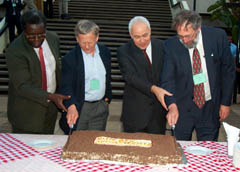 He noted, however, that the CBD child is poorly equipped and lacks
resources for education, despite having certain wealthy parents.
He reminded participants of the tremendous contribution of the late
Arthur Campeau, head of the Canadian delegation during the negotiation
of CBD text. Koester added that Campeau would have been proud to
see the CBD develop as it has, happy with the Biosafety Protocol
and pleased with the good atmosphere at this COP-5.
He noted, however, that the CBD child is poorly equipped and lacks
resources for education, despite having certain wealthy parents.
He reminded participants of the tremendous contribution of the late
Arthur Campeau, head of the Canadian delegation during the negotiation
of CBD text. Koester added that Campeau would have been proud to
see the CBD develop as it has, happy with the Biosafety Protocol
and pleased with the good atmosphere at this COP-5.
John
Hurley, head of the COP-5 Canadian delegation [bottom photo,
far right] lead participants in a rendition of "Happy Birthday,"
then cut the birthday cake with Veit Koester.
|
|
|
Side event:
BioNET International and the Global Taxonomy Initiative
|
|
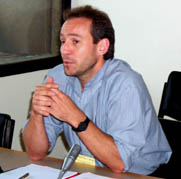 BioNET-International
held a workshop to discuss interactions and collaboration of its
Global Network for Taxonomy with the CBD's
Global Taxonomy Initiative (GTI) . BioNET-International
held a workshop to discuss interactions and collaboration of its
Global Network for Taxonomy with the CBD's
Global Taxonomy Initiative (GTI) .
Nicholas
King, Director of BioNET International [nking@cabi.org,
right], facilitated discussion on "fast-track" implementation
of taxonomic capacity-building objectives of GTI via existing BioNET
Locally Organized & Operating Partnerships (LOOPs) rather than through
new regional and national nodes, and possible project concepts for
submission for GTI funding, such as the repatriation of taxonomic
information.
Ian
Cresswell, GTI Programme Officer, CBD Secretariat [ian.cresswell@biodiv.org],
invited input on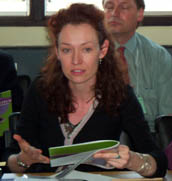 how best to implement and facilitate CBD taxonomic initiatives at
the national and international levels.
how best to implement and facilitate CBD taxonomic initiatives at
the national and international levels.
Kerry
Ten Kate, Head of Conventions and Policy Section, Royal
Botanical Gardens at Kew, [ktenkate@rbgkew.org.uk,
left], said that Royal Botanical Gardens at Kew and other ex
situ conservation and research institutions could repatriate
both raw data and results of research to countries of origin in
light of CBD Sub-Articles 17.1 and 17.2. She said that such repatriation
efforts should proceed in the following stages: a needs assessment
to identify a "wish list" of material for repatriation; a supply
assessment identifying institutions outside the country that may
have such itemized materials; making contacts with appropriate ex
situ institutions; elaboration of a budget and seeking of funds;
execution of repatriation; and follow-up mechanisms to ensure that
repatriation is part of an ongoing process. Contact Ms. ten Kate
for a copy of "Going Home: A Manual on the Repatriation
of Information from Ex-Situ Conservation and Research Institutions
to Countries of Origin," written by Manolo Ruiz, Rachun
Pooma, Martin Jenkins and Kerry ten Kate and published by the Kew
Darwin Initiative.
|
|
|
Side event: Awareness and
Education "Hot Spots:" Helping Article 13 Work for Biodiversity
|
|
A
workshop on implementing Article 13 on the CBD public education
and awareness-raising strategy and ways to make biodiversity realistic
and tangible to more actors was convened by the Ministry of Environment,
Norway and the IUCN Commission on Education and Communication (CEC),
a global network of experts in environmental communication and education.
Sylvi
Ofstad, COP-5 Delegate of Norway [sylvi.ofstad@md.dep.no,
right], urged delegates to call for development of education
and awareness materials by the CBD Secretariat for Parties and Ministries
of Environment and endorsement of the SBSTTA recommendation that
education and communication strategies be directly linked to and
included in specific CBD work programs. 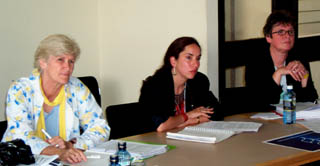 She
suggested that Parties consider UNESCO be a key partner with formal
education strategies and request GEF support for collaborative communication
processes on biodiversity with the involvement of all local and
regional stakeholders, including children, indigenous peoples and
the private sector. She
suggested that Parties consider UNESCO be a key partner with formal
education strategies and request GEF support for collaborative communication
processes on biodiversity with the involvement of all local and
regional stakeholders, including children, indigenous peoples and
the private sector.
Ana
Puyol, Delegate of Ecuador [center], said communication and
education strategies should be incorporated in every CBD work programme,
but prioritized. She proposed that COP-5 delegates give priority
to Article 8(j), capacity building in this area and launch a technical
cross-cutting thematic working group on developing CBD public education
and awareness programmes.
Wendy
Goldstein, Head of the IUCN Education and Communication Programme
[wjg@hq.iucn.org], asked
delegates for to propose options for elevating Article 13's profile.
For follow-up, notes of the session, or a copy of the GBF's report
Public Education and Awareness: How to Put It into Practice,
please contact Ms. Goldstein at the above e-mail address.
Participants
considered the possibilities of: the Secretariat working with others
such as UNESCO, IUCN, OECD, UNITAR and journalist organizations
to develop a training manual and capacity-building schemes to assist
Parties in their national and regional implementation of biodiversity
publicity campaigns and education; expanding GEF, regional institutions
and multilateral development bank support for CBD information-training
through formal and informal educational channels; cooperation with
the private sector, particularly the garden, pet and aquarium industries,
to reach households directly; and collaborating with indigenous
peoples to improve their leadership and community access to CBD
information, especially on Article 8(j).
|
|
|
Side event: The GEF, Ecosystems
and Agrobiodiversity
|
|
 Colin
Rees, Leader of the Global Environmental Facility's Biodiversity
and International Waters [crees@worldbank.org,
pictured here on the right] chaired a workshop hosted by the
GEF Secretariat on the agrobiodiversity and ecosystem operational
programmes recently adopted by the GEF Council. Colin
Rees, Leader of the Global Environmental Facility's Biodiversity
and International Waters [crees@worldbank.org,
pictured here on the right] chaired a workshop hosted by the
GEF Secretariat on the agrobiodiversity and ecosystem operational
programmes recently adopted by the GEF Council.
Herbert
K. Acquay, Leader of the GEF Land and Water Resources Team [hacquay@worldbank.org,
bottom photo on the left] gave an overview of the GEF' s role,
scale of support, operational requirements and existing operational
programmes on agrobiodiversity, drylands, forests, coastal, marine,
mountains and freshwater resources.
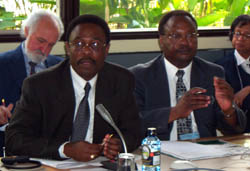 Walter
Jami Lusigi, Senior GEF Biodiversity Advisor [wlusigi@worldbank.org,
bottom photo on the right] described the GEF Operational Programme
on Agricultural Biodiversity, Land Degradation Action Plan, Africa
Land and Water Initiative and Operational Programme on the Ecosystem
Approach. Regarding the Programme on Agricultural Biodiversity,
he said that it contributes to CBD objectives by integrating agricultural
ecosystems into the broader landscape, and conserves wider ecological
services such as clean water, erosion control and microclimate stabilization.
In addition, for dryland, the GEF is strongly positioned to fund
biodiversity-friendly Desertification Convention provisions despite
not being the financial mechanisms for the latter convention. Walter
Jami Lusigi, Senior GEF Biodiversity Advisor [wlusigi@worldbank.org,
bottom photo on the right] described the GEF Operational Programme
on Agricultural Biodiversity, Land Degradation Action Plan, Africa
Land and Water Initiative and Operational Programme on the Ecosystem
Approach. Regarding the Programme on Agricultural Biodiversity,
he said that it contributes to CBD objectives by integrating agricultural
ecosystems into the broader landscape, and conserves wider ecological
services such as clean water, erosion control and microclimate stabilization.
In addition, for dryland, the GEF is strongly positioned to fund
biodiversity-friendly Desertification Convention provisions despite
not being the financial mechanisms for the latter convention.
For
more information on eligibility criteria for GEF funding, visit
[http://www.gefweb.org]
|
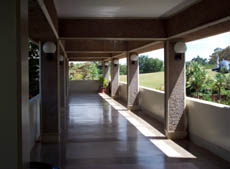 IN
THE BREEZEWAYS IN
THE BREEZEWAYS
While delegates await the arrival of Ministers and the signing of
the Protocol, the ghosts of Cartagena and Montreal reared their
heads in Plenary discussion on the ICCP's work plan. Many of the
voices were the same as those heard at the biosafety roundtable
negotiations, and the issue of identification and documentation
was the same one that concluded the negotiations in Montreal. Delegates
noted that such tensions might be inevitable in a preparatory process
that is supposed to facilitate the Protocol's implementation on
core, and sometimes contentious items, while supposedly not being
substantive negotiations themselves. Right:
at the UN compound at Gigiri, buildings are not separated
by closed corridors, instead they are linked by open breezeways.
|
|



